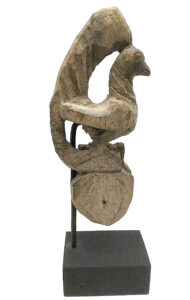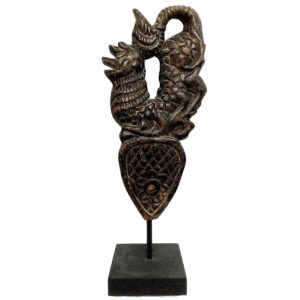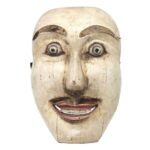Burmese Heddle Pulleys: Functional and Aesthetic Weaving Tools
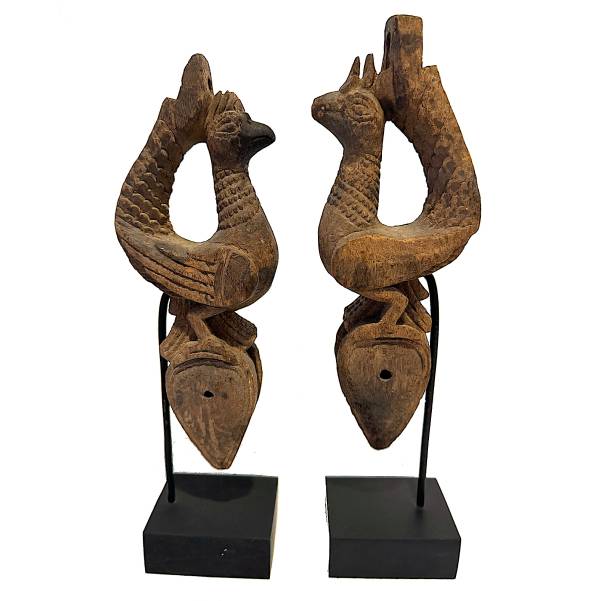
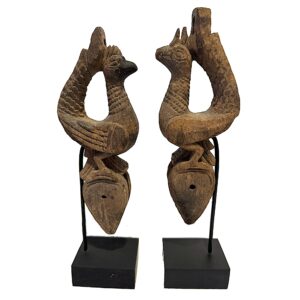
Textiles are hand crafted in many counties around the world using a loom that hold the stretched vertical threads (warp), also known as surface threads or ends. As they must be tight, they are normally stronger than the horizontal threads (weft). The vertical warp threads facilitate interweaving by guiding the horizontal ones alternating over and under. A cord or wire heddle is another basic part of a loom, as each of the vertical threads pass through the eye in the heddle’s center and are suspended on the loom’s shaft so each of the vertical threads can be separated and enable the weft to pass through. This is made easier using decorative heddle pulleys usually carved in pairs used by the weaver to move the heddles in order to separate the threads and effortlessly push through the shuttle securing the warp thread.
Heddle pulleys were used in strip weaving, a process using a small strip-loom to produce long, narrow strips of cloth later sewn together to create a larger textile such as blankets and ritual cloths. As the looms were small, highly portable, and easily assembled, it was easy for the weaver to carry them to the person who commissioned the textile to see the progress made on the work. The weavers use their feet to operate the heddles alternately for the process of weaving. This kind of weaving is created all over the world, but especially in Africa and Asia as are finely carved heddle pulleys.
Made to be both functional and aesthetic heddle pulleys made moving the heddles attached to the warp threads easy and helped the shuttle with the weft thread to pass through, but they were also a source of pride for the carver. Such pieces were often decorated with carvings of figures or animals often symbolizing auspicious beings important to the indigenous culture where they originated. Many scholars also believe that they were propitious images protecting the weaver using them and assured those produced were of good quality in order to please both the gods and spirits. In Africa, they also called attention to the skills of the sculptor who carved it and were a notice for his availability for work to create other art, such as shrine figures, masks, or more.
Scholars believe that these heddle pulleys were decorated with propitious animals, birds, and mythological beings to assure good quality from the carver and weaver and also to attract the favor of local spirits. Among Burmese carvers the animals, birds, and other designs on heddle pulleys are portrayed with the tail touching the head to solve the practical matter of providing an area in the rear for the thread used for weaving travel down the back of the animal and to a flanged bobbin. They usually sit on a heart, oval, or round shaped double sided base with the bobbin secured inside with a wood peg.
The most common motifs Burmese heddle pulleys motifs are peacocks, hamsas, and singhas.
Peacocks
The peacock, the emblem of the Burmese Kon-baung Dynasty (1752-1885) and symbol of the monarchy descending from the sun, remains a favorite decorative icon in Burma, Thailand, and India. The peacock is significant in Hinduism where it is used as a symbol of the cycle of time and was closely associated with the Saraswati and Krishna, and there are many Indian tales about the bird’s beauty and feathers which are said to bring good luck and prosperity to the home. In Buddhism, especially the Theravada Buddhism that is practiced in Burma, the Jakata Tales portrays the peacock as the image under which a Bodhisattva teaches renunciation of worldly attachments. A peacock with outspread tail feathers was a prevalent motif over entrances of religious and government buildings, and of the 108 images on the large sculptures with motifs on the Buddha’s footprints, the peacock is number 83. (Myint) In esoteric Buddhism the peacock is a symbol of wholeness, since it combines all colors when it spreads out its tail in a fan. It exhibits intrinsic identity and the short-lived nature of all things, since its form appears and vanishes as swiftly as the peacock displays and furls its tail. In Burma, the peacock is especially significant, as it represents the sun. (Myint) In Buddhist belief, peacocks are believed to be able to eat poisonous plants without being affected and so are considered a symbol of long life and also synonymous with the great bodhisattvas, as a bodhisattva is able to take delusions as the path toward liberation and transform the poisonous mind of ignorance, desire, and hate into thoughts of enlightenment, which is said to open colorfully like the peacock’s tail. The Buddhists consider the peacock a symbol of purity, and this has resulted in their feathers being heavily relied upon for performing purification ceremonies. Finally, there is a Buddhist sutra called The Buddha Mother Great Peacock Wisdom King Sutra in which Buddha tells his oldest companion and principal disciple Ananda, “This peacock king is my body,” and the sutra also declares “peacock tails symbolize the overcoming of misfortune.” (Ven. Shan Ci)
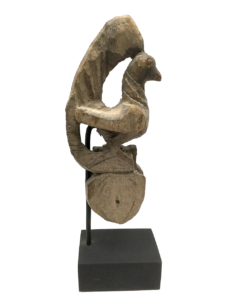
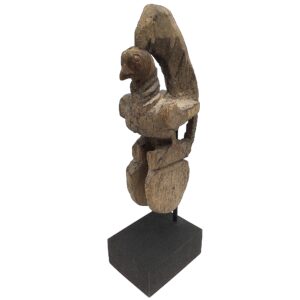
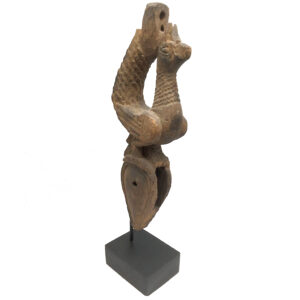
Hamsas
A hamsa, also known as a hin-tha, is a mythical goose or swan image frequently used in folk, Buddhist, and Hindu art in Southeast Asia. The hamsa is one of the many creatures referred to in the Jataka Tales written about the former lives of The Buddha. It is found on sacred objects as well as everyday utilitarian items such as looms, metal opium weights, and woodcarvings. The footprints of the Buddha contain 108 signs of which no. 73 is a hamsa. It is believed that in his previous lives the Buddha was born as animals and birds, and of his 136 lives, the 9th life was experienced as a hamsa. The hamsa is also the Hindu creator god’s vahana, the vehicle or animal upon which Hindu deities sit and travel and symbolizes wisdom and the ability to discriminate between right and wrong. The goose is also associated with Saraswati, the goddess of knowledge and creativity, and it represents the spirit or soul, divine knowledge, and the ability to make the mind commune on all levels. The hamsa also has the ability to separate milk from water symbolizing understanding, discrimination, and knowledge of a spiritual nature. They are often depicted on heddle pulleys with deeply carved feathers on their neck, wings, and chest and the head is usually topped with a crowning feather that extends to arched tail feathers.
Buddhist Lions
The lion, (called singha in Sanskrit and chinthe in Burma), a guardian figure and the protector of Buddhist Law, has always been strongly associated with Buddhism. Shakyamuni, the historical Buddha, means king of the lion clan. The lion is king of the beasts and its roar, which can be heard for great distances, is compared to the strength of the Buddha’s teachings and its quick dissemination throughout the land. In The Lotus Sutra Buddha Shakyamuni is referred to as “lion of the Shakyas” and the “Sage Lion,” in Buddhist sutras the word for lion is written in two characters that mean “teacher” and “disciple.”
The singha/chinthe depicted here is a powerful beast with its mouth open in a roar bearing its teeth, glaring eyes, a thick and powerful neck covered with a thick mane, and hair piled on top of the head, all reinforcing his ferocity. His feet firmly rest on top of the downward-pointing triangle that pushes his body unnaturally high on its hind legs and bends its tail up and forward so it touches its head. This convention of a tail touching the head is often used for animals depicted on Burmese heddle pulleys to provide an area in the rear for the thread to be able to travel down the back of the animal to a flanged bobbin. The fine and deep carving throughout the piece reflects the carver’s many skills.
Heddle pulleys were less common in Asia than elsewhere, simply because Asian weaving traditions rarely included long, narrow strips of woven cloth in their repertoire. On the contrary, most Asian weaving traditions involved the inclusion of complicated decorative motifs in most areas of a piece of cloth. Even when there were large areas of a dominant color, there were usually fine decorative motifs woven within those areas, and usually, if different pieces were to be joined together later in the weaving process, each part would probably be too wide and the design too complicated to be finished using the strip-weaving process. The lion is still a symbol of strength and courage.
Sources
Fredrick W. Bunce, A Dictionary of Buddhist and Hindu Iconography, New Delhi, D.K Printworld, 2001.
Sylvia Fraser-Liu, Burmese Crafts Past, and Present, Kuala Lumpur, Oxford University Press, 1994.
Online Sources
blog.buddhagroce.com, Buddha Grove, “The Spiritual Significance of Peacocks”
Aye Myint, My Country Myanmar, Animals and Birds, Goldenland Pages
Dharmablogspot, Mora Sutta, “The Discourse on the Peacock’s Prayer”
worldtrinbune, “What is the connection between lions and Buddhism?”

